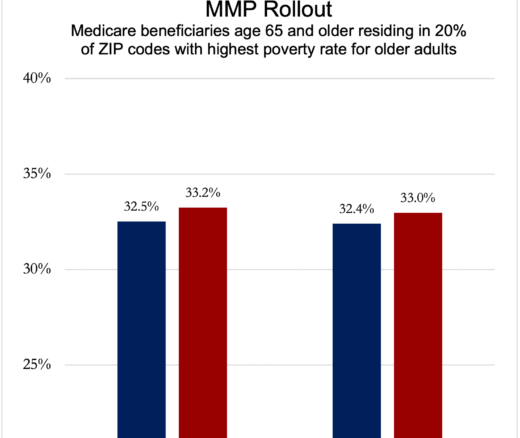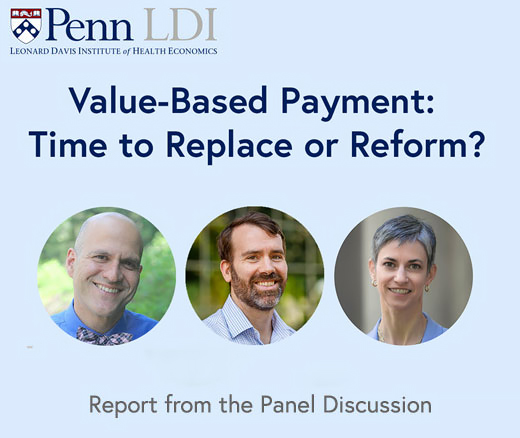
Black Older Adults With Cancer Are Far Less Likely to Get Any Care
New Study From LDI and MD Anderson Finds That Black and Low-Income, Dually Eligible Medicare Patients Are Among the Most Neglected in Cancer Care
News

Powered by the COVID-19 national emergency, a Medicare waiver, and an innovative wave of remote health care delivery technology, the hospital-care-at-home field has exploded into a $143 billion national market. And yet, its benefits and disadvantages in comparison to inpatient hospital care remain largely unknown as the growth of the new industry has far outpaced the scientific studies needed to determine whether transferring huge amounts of hospital care into patients’ homes makes long-term financial or medical sense.
Addressing these unanswered questions was the goal of last week’s four-day Global Health Care, LLC National Advanced Healthcare at Home Summit. The event brought together academic researchers, policymakers, health care executives, and investment analysts to discuss the way forward in a market now expected to grow to $254 billion over the next seven years.
The continuing rise of the hospital-care-at-home—or advanced-care-at-home—model is expected to ultimately keep millions of patients out of hospitals. That obviously portends serious changes in revenue and operations for the hospital industry as many of those facilities may become the hubs of technology and staffing for vast networks of remote home-based management of acute illness.

In the context of the country’s current concern over run-away health care costs, there are many unresolved fundamental questions. For instance: Should care delivered at home outside of the normal high capital costs of in-hospital care be reimbursed at the same rate as hospital care or at a substantially reduced rate that reflects the shift into a lower cost environment?
A related issue that has received little public attention is the inevitable reality that the business of providing hospital-level care in the home assumes that a patient’s family members will willingly become unpaid caregivers in ways that can disrupt their own lives and jobs, as well as affect their mental or physical health.
Friday’s closing plenary session at the Summit, “Health Economists’ Perspectives on the Implications of Moving More Healthcare to the Home,” was moderated by the former Editor-in-Chief of Health Affairs and current Chief Executive Officer of America’s Physician Groups Susan Dentzer. The two panelists were Rachel M. Werner, MD, PhD, Executive Director of the Leonard Davis Institute of Health Economics (LDI) and Professor of both Health Care Management and Economics at the Wharton School and Medicine at the Perelman School of Medicine; and Michael E. Chernew, PhD, Chair of the Medicare Payment Advisory Commission (MedPAC) and Professor of Health Care Policy at the Harvard Medical School.
“From the payers’ perspective, the studies we have to date show that hospital-at-home care saves money,” said Werner. “The payments that we’ve been making to hospitals have been quite generous. But even with those very generous payments, the amount that is spent by payers is lower than it would have been if the patients go to the hospital. We don’t know the costs [from the] hospitals’ perspective because nobody has really looked at that yet. And from a societal perspective, we don’t have patient data about what happens when people get diverted home, including the burdens for home caregivers in this setting.”
“We also know that when people go from being in an institutionalized setting with monitoring 24 hours a day, seven days a week to a home-based setting with intermittent monitoring, there are more complications, there’s more hospital admissions,” Werner continued. “And that’s to be expected because you’re going to a much less monitored setting, particularly as patients get sicker. So, I think we just don’t know how much of that is going to happen but shouldn’t be surprised when there are complications and hospitalizations that were unanticipated.”

“My general thinking is that the answers to these questions largely depend on how the overall thing is implemented,” said Chernew who noted he was speaking personally as a Harvard Professor and not as Chair of MedPAC. “What are the prices? Who determines who’s eligible for the various services? Implementing the advanced-care-at-home model in a Medicare Advantage program where you would have some utilization management and fee negotiations could be very different from implementing it in a Medicare fee-for-service program. “
Werner pointed out the workforce challenges posed by a nationally implemented permanent model of advanced care. “In the current hospital setting, there’s a well-known workforce shortage, particularly among nurses. And the efficiency of care for nurses is much higher in the hospital than it is in the home-based setting. So, do we have the workforce to really implement a hospital-at-home setting, where there’s built-in transportation time and things like that? I’m not sure we have that workforce and I worry about the caregiving costs and who’s going to make up for the time that the nurses and the doctors aren’t there in the house.”
Werner also pointed out that much like the rest of health care with less accessibility for rural populations, the lack of broadband access will limit access to hospital-care-at-home across these geographic regions because remote monitoring is dependent on robust internet connections that aren’t there.
One of the most dramatic innovations that took hold during the pandemic was the use of new kinds of digital remote monitoring systems to “decant” massive patient overloads from hospitals. Systems like the University of Pennsylvania Health System’s COVID WATCH enabled constant, close monitoring of the changing symptoms and conditions of large numbers of COVID-19 patients in their homes. The success of these program supercharged the hospital-care-at-home movement. It also raises the question of how the entire hospital industry might ultimately be changed as its revenue streams from in-patient care increasingly dry up as more and more patients receive care beyond their walls.

“If you take a step back and look at the longer-term trends in hospital census, it’s been declining for the past decade or more. It is likely it will continue to decline as we shift more care out of hospitals and prevent hospitalizations,” said Werner. “Hospitals are probably going to shrink in capacity as a result, and I don’t think that that necessarily is a problem. What I worry about more is access to hospital care when and where one needs it. So, we need to have some idea about the geographic distribution of hospitals–where they are located and whether everybody has access to them. But in the larger picture, I do think that hospitals will always exist. The role they play may change but that’s going to happen very slowly.”
The session ended with thoughts about the types of research needed to inform policymakers’ decisions about what will be done after the pandemic Medicare Waiver that has fueled the hospital-care-at-home trend ends in 2024.
Chernew said he favors “less randomized work and more quasi experimental work as we see this trend progress in Medicare Advantage plans. The money would be used to understand what types of patients are involved and how much the plans like those patients. The trick is to do it in a way that mimics how it would be done in the real world. You would let it play out as opposed to designing a big, randomized trial to get the answer that will precisely tell you what happened in that trial protocol. But that would still leave you unsure what would happen if you try to generalize from those results.”
“I want large randomized, real-world trials,” said Werner. “We have an opportunity, like we’ve done in other cases, to randomize markets to different interventions. And that is really helpful in producing rigorous evidence and understanding what’s happening. Rather than rolling out hospital care at home across all markets, perhaps we can just do it in a random segment of markets and have some markets randomized to a control. That would really provide a lot of evidence to help us understand the questions that have been raised here today.”

New Study From LDI and MD Anderson Finds That Black and Low-Income, Dually Eligible Medicare Patients Are Among the Most Neglected in Cancer Care

Her Transitional Care Model Shows How Nurse-Led Care Can Keep Older Adults Out of the Hospital and Change Care Worldwide

Chart of the Day: Medicare-Medicaid Plans—Created to Streamline Care for Dually Eligible Individuals—Failed to Increase Medicaid Participation in High-Poverty Communities

Penn LDI Debates the Pros and Cons of Payment Reform

Direct-to-Consumer Alzheimer’s Tests Risk False Positives, Privacy Breaches, and Discrimination, LDI Fellow Warns, While Lacking Strong Accuracy and Much More

One of the Authors, Penn’s Kevin B. Johnson, Explains the Principles It Sets Out

Six Lessons the U.S. Can Learn from Europe About Protecting Health Data Linkages

Testimony: Delivered to Philadelphia City Council’s Committee on Labor and Civil Service

Moving from Fee-for-Service to Risk-Based Contracts Hasn’t Dramatically Changed Patient Care, Raising Questions About How to Make These Models More Effective